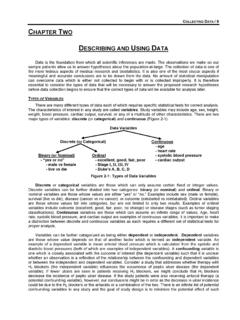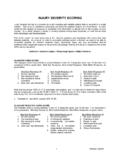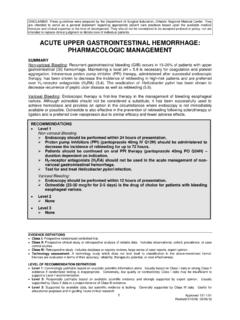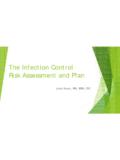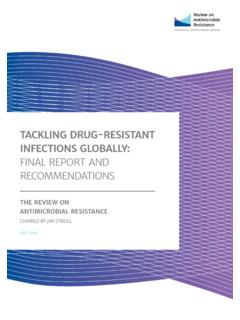Transcription of EMPIRIC ANTIBIOTIC USE IN CRITICALLY ILL PATIENTS
1 DISCLAIMER: These guidelines were prepared by the Department of Surgical Education, Orlando Regional Medical Center. They are intended to serve as a general statement regarding appropriate patient care practices based upon the available medical literature and clinical expertise at the time of development. They should not be considered to be accepted protocol or policy, nor are intended to replace clinical judgment or dictate care of individual PATIENTS . EMPIRIC ANTIBIOTIC selection should be based on local susceptibility patterns of microorganisms.
2 1 Approved 5/08/2007 EMPIRIC ANTIBIOTIC USE IN CRITICALLY ILL PATIENTS SUMMARY Inappropriate EMPIRIC ANTIBIOTIC therapy is widespread and associated with increased mortality in CRITICALLY ill PATIENTS . Initial ANTIBIOTIC selection must account for a variety of host, microbiologic, and pharmacologic factors. Institution-specific data, such as susceptibility patterns, must also be considered. Tailoring antimicrobial therapy based upon culture and sensitivity results will help to reduce costs, decrease the incidence of superinfection, and minimize the development of resistance.
3 INTRODUCTION Inappropriate EMPIRIC ANTIBIOTIC therapy is widespread and associated with increased mortality in CRITICALLY ill PATIENTS . Although published consensus statements can provide general concepts by which to guide EMPIRIC ANTIBIOTIC selection, they are limited by a failure to incorporate local pathogen susceptibility patterns. There is considerable variability in the frequency of infections, spectrum of potential pathogens, and susceptibility patterns between different ICU s as well as subsets of PATIENTS within the same ICU.
4 Several factors must be considered when selecting EMPIRIC antimicrobial therapy: Patient-specific factors Presumed source of infection ( , blood, sputum, urine, intra-abdominal) Presence of co-morbid conditions ( , recent surgery or trauma, chronic illness) Previous ANTIBIOTIC administration history Microbiological factors Identification of the most likely pathogens and their unit-specific susceptibility patterns Pharmacologic factors Potential drug toxicity ( aminoglycosides)
5 Bioavailability Distribution to the site of infection RECOMMENDATIONS Level 1 None Level 2 Direct EMPIRIC antimicrobial selection at the most likely source of infection based upon clinical and microbiological data. Perform a risk assessment for the presence of multi-drug resistant organisms by reviewing the patient s prior microbiologic data and antimicrobial use. Consider initiating antifungal therapy in PATIENTS at risk (see Management of Candida Infections in Surgical PATIENTS guideline).
6 Select combination therapy with agents from different classes for initial gram-negative coverage to increase the likelihood of susceptibility. Level 3 Perform focused diagnostic tests and procedures according to the Fever Assessment Guidelines . For PATIENTS with severe sepsis, initiate EMPIRIC antimicrobial agents within one hour. Tailor antibiotics based on culture and susceptibility results. For gram-negative infections, there is insufficient evidence to support routine combination therapy to achieve synergy or prevent resistance.
7 In the absence of a clear survival advantage to combination gram-negative coverage, the decision to tailor ANTIBIOTIC administration to monotherapy should be based on patient-specific factors. 2 Approved 5/08/2007 Any EMPIRIC ANTIBIOTIC regimen should be reassessed and tailored as soon as culture and sensitivity results become available. This practice serves to reduce costs, decrease the incidence of superinfection and minimize the development of antimicrobial resistance.
8 The EMPIRIC use of vancomycin deserves special consideration. Widespread antimicrobial therapy with this agent has contributed to a significant increase in vancomycin-resistant enterococcal (VRE) infections. The potential transfer of resistance to more virulent organisms such as Staphylococcus aureus and Staphylococcus epidermidis poses a significant public health threat. As a result, the Centers for Disease Control (CDC) has published recommendations for the prudent use of vancomycin in a document addressing the prevention and control of resistance (1).
9 LITERATURE REVIEW Early Appropriate Antimicrobial Therapy A recent focus regarding antimicrobial therapy emphasizes the importance of early initiation of appropriate ANTIBIOTIC therapy. Delays in effective antimicrobial coverage are associated with a detrimental impact on patient morbidity and mortality, with an increased risk of sepsis, higher costs, and increased ventilator days for PATIENTS with ventilator-associated pneumonia (VAP) (2). Tailoring of antibiotics once cultures are available may not compensate for initial inadequate therapy (Class II).
10 In a prospective, cohort study of CRITICALLY ill PATIENTS , the relationship between inappropriate EMPIRIC antimicrobial therapy and outcome was evaluated (3). Multivariate analysis demonstrated that inadequate antimicrobial treatment of nosocomial infections was a risk factor for hospital mortality (adjusted OR ; p< ). VAP and bloodstream infections accounted for 89% of inadequately treated nosocomial infections. The most common gram positive and gram-negative organisms associated with inadequately treated VAP were oxacillin-resistant Staphylococcus aureus and Pseudomonas aeruginosa, respectively.


